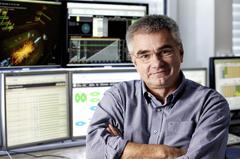URL: https://www.desy.de/news/news_search/index_eng.html
Breadcrumb Navigation
DESY News: LHC restarts - sets course to new territories
News
News from the DESY research centre
LHC restarts - sets course to new territories
After a two-year shutdown, the world's largest particle accelerator LHC at the European particle physics laboratory CERN has been restarted. The shutdown prepared the Large Hadron Collider to smash particles together with higher energy than ever before. These particle collisions will open the view to previously uncharted territory. At least that's what researchers around the globe are hoping, also at DESY, where two large groups of scientists are heavily involved in the work with the LHC detectors ATLAS and CMS.

DESY-Teilchenphysikdirektor Prof. Joachim Mnich. Bild: Heiner Müller-Elsner/DESY
The discovery of the Higgs particle in 2012 was not only a glorious confirmation of the very successful Standard Model of particle physics, but also a crucial step towards opening the door to a new physics that extends beyond this model. “In the years ahead, we will measure the properties of the Higgs particle as precisely as possible,” says Mnich. “Should we discover tiny deviations from the predicted values, this could be crucial evidence of a previously unknown physics that would expand our worldview beyond the models that have been verified to date.”
This research might uncover the avidly looked-for supersymmetric particles – or something completely different. “One of the biggest questions is the nature of dark matter,” explains Mnich. That’s because the successful Standard Model of particle physics explains only the five percent of the matter in the universe that we are familiar with. Astronomers have observed another kind of matter, one that isn’t visible and is only revealed by its gravity. Even though this dark matter is five times more common than the matter we are familiar with, its nature is a complete mystery. Many physicists hope that the LHC will discover possible candidates for dark matter.
“Unfortunately, we don’t even know if dark matter consists of particles,” says Mnich. “We know that dark matter interacts with other matter through gravity. We hope that it is also subject to the weak interaction, which is responsible for radioactive decay, among other things. If this is not the case, it will be very hard to find particles of dark matter in an accelerator.” Supersymmetric particles are also possible candidates for dark matter.
But even if physicists should discover anything about the nature of dark matter, they still won’t be able to thoroughly explain the cosmos. That’s because more than two thirds of the content of our universe consists of a mysterious dark energy, which seems to be pushing space itself apart. Astronomical observations have detected this dark energy, but scientists still have no clue as to what it might be.
One of DESY’s particular strengths continues to be the analysis of proton structure, the thorough understanding of which is crucially important for future Higgs research at the LHC. This accelerator collides protons with other protons, and the collisions do not provide a clear picture unless it is know in detail what is colliding with what. Nowhere has the interior of the proton been more precisely investigated than at DESY’s HERA accelerator.
But simply carrying out experiments is not enough. “We also have to understand the experiments,” Mnich points out. “You need a theoretical basis to do that. The crucial thing is to combine the results of accelerator experiments with those of astronomical observations. At DESY, we have an extremely effective theory group, that also offers a unique environment for up-and-coming young scientists.”

Read more in DESY's research magazine femto
“But is nature really so simple that there is ultimately only a single force?” asks Mnich. “We won’t be able to answer this question anytime soon. However, we might get hints in the coming years that will tell us where it’s worthwhile to look.”
###
Read more in DESY's research magazine femto at http://www.desy.de/femto_eng/index_eng.html



